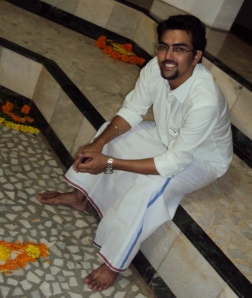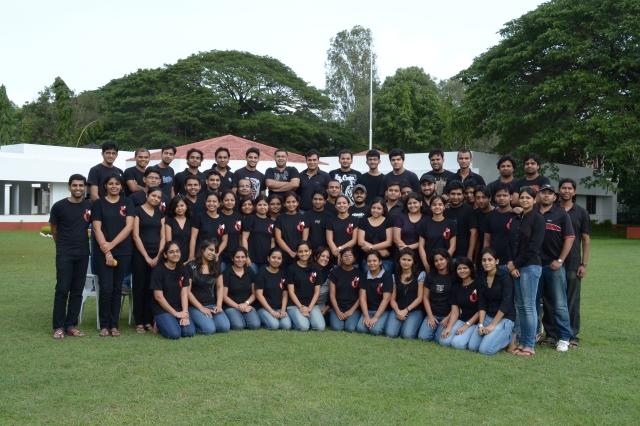 When Bharat Sharma was selected for a Summer Internship at Kalyani-Lemmerz Ltd. in Pune, he knew it was going to be an acid test of the management skills acquired at KIAMS. Kalyani-Lemmerz is a JV between the Kalyani Group and Hayes Lemmerz, Germany – the world leader in wheel rim technology, supplying to automotive manufacturers like Daimler Benz, General Motors, Ford and Volvo, among others. The KLL management had outlined a very clear-cut Operations project for him – how to reduce the cycles time of the machines on the shop floor. A B.Tech in Electronics and Communication, Bharat knew well that his Engineering background was going to be of little use in the KLL manufacturing unit in Khed, Pune. The success or failure of his SIP would depend entirely on the ‘KIAMS effect’. When he embarked on his journey from Harihar to join KLL, Pune, there were many doubts in his mind, but if there was one thing he was absolutely sure about, it was that the KIAMS family would stand by him, come what may.
When Bharat Sharma was selected for a Summer Internship at Kalyani-Lemmerz Ltd. in Pune, he knew it was going to be an acid test of the management skills acquired at KIAMS. Kalyani-Lemmerz is a JV between the Kalyani Group and Hayes Lemmerz, Germany – the world leader in wheel rim technology, supplying to automotive manufacturers like Daimler Benz, General Motors, Ford and Volvo, among others. The KLL management had outlined a very clear-cut Operations project for him – how to reduce the cycles time of the machines on the shop floor. A B.Tech in Electronics and Communication, Bharat knew well that his Engineering background was going to be of little use in the KLL manufacturing unit in Khed, Pune. The success or failure of his SIP would depend entirely on the ‘KIAMS effect’. When he embarked on his journey from Harihar to join KLL, Pune, there were many doubts in his mind, but if there was one thing he was absolutely sure about, it was that the KIAMS family would stand by him, come what may.
“The one thing that I absolutely love about KIAMS is its diversity of students and faculty. And yet, it always feels like you are part of one big family. Coming from the extremes of Noida and Jaipur, the moderate climate and greenery at KIAMS have been a welcome change. But if there is one thing that is a hallmark of my first year at KIAMS, it has to be the vast amount of experiential learning that came my way. Probably because of the formidable Kirloskar brand, KIAMS actually presents a small sample of corporate life to its students. In hindsight, all this was great preparation for the SIP at Kalyani-Lemmerz.”
Everyday for the next two months, Bharat Sharma was on the KLL shop floor at 8:30 AM Sharp, moving from one machine to the other, noting the cycle time and observing the process. At all these times, he also keeps a sharp eye out for any area where time could be reduced by applying the Operations Management concepts taught at KIAMS. There were huge challenges he faced in order to do this. He was required to conduct motion studies on machine operators, but a motion study is done on a single operator on a daily basis, while operators on the shop floor were not fixed, but worked on a contractual basis. This meant that the operator that was his subject for motion study on a given day may not have been present the day after that. The other big challenge was that quite a few of the activities that were time consuming and contributed to cycle time were safety measures for the operators. Challenging these measures without due thought could have proved hazardous.
“The Production Manager was very supportive, and guided me well at the conceptual level. The Line Supervisor was also of help at the hands-on level. But for all practical purposes, I don’t think I would’ve been able to get far without the always-at-hand support of my faculty mentor, Prof. E. Anand, and my alumni mentor, Dill Saphal. Almost on a daily basis, I would be involved in detailed discussions on the challenges I faced, and my mentors and faculty members at KIAMS would be sharing focused reading material with me, which was invaluable.”
It was an altogether different high for Bharat Sharma when, after just two months of internship, three of his recommendations for reducing cycle time were accepted and implemented by the management on the shop floor of Kalyani-Lemmerz Ltd. At the end of his SIP, Bharat was appreciated by the Plant Head as well as the VP, HR, for doing a “great job”.
“Right from scheduling my interview at Kalyani-Lemmerz (by Ms. Shruti Das of the Placement Cell), to getting the right mentors, KIAMS played the supporting role to perfection. It is for this reason that I would like to advise my juniors to always be in touch with their faculty guides and mentors at KIAMS as they have seen their students closely not just in the classes, but also through the SIPs . They are the best guides and advisors that they are likely to have.”
Bharat Sharma is now absolutely certain that the best attitude to carry to the corporate world is ‘stay hungry, stay foolish’. He credits KIAMS with showing him that in today’s world it is no longer the fittest who will survive, but the ones who are capable of adapting to given circumstances.







